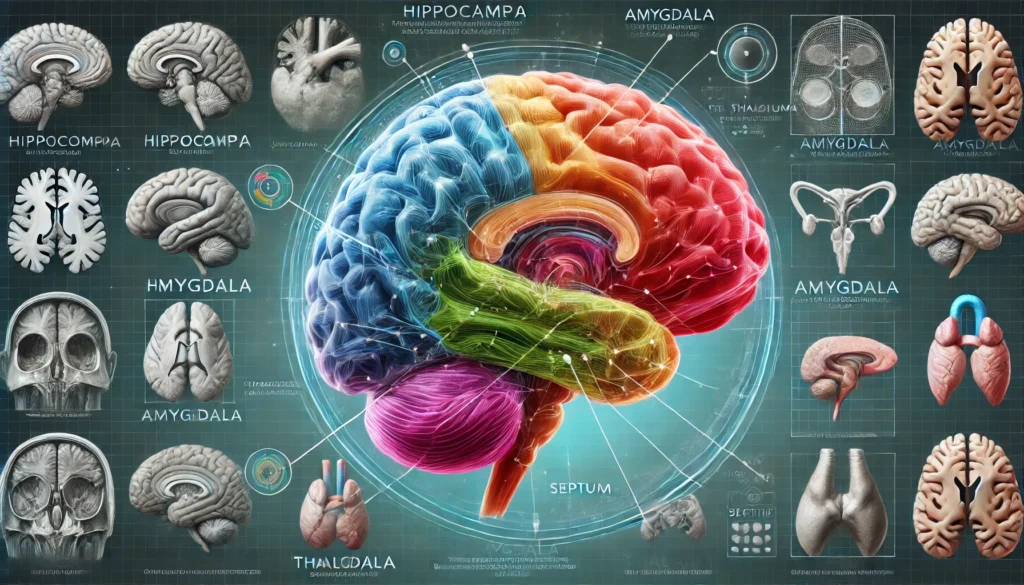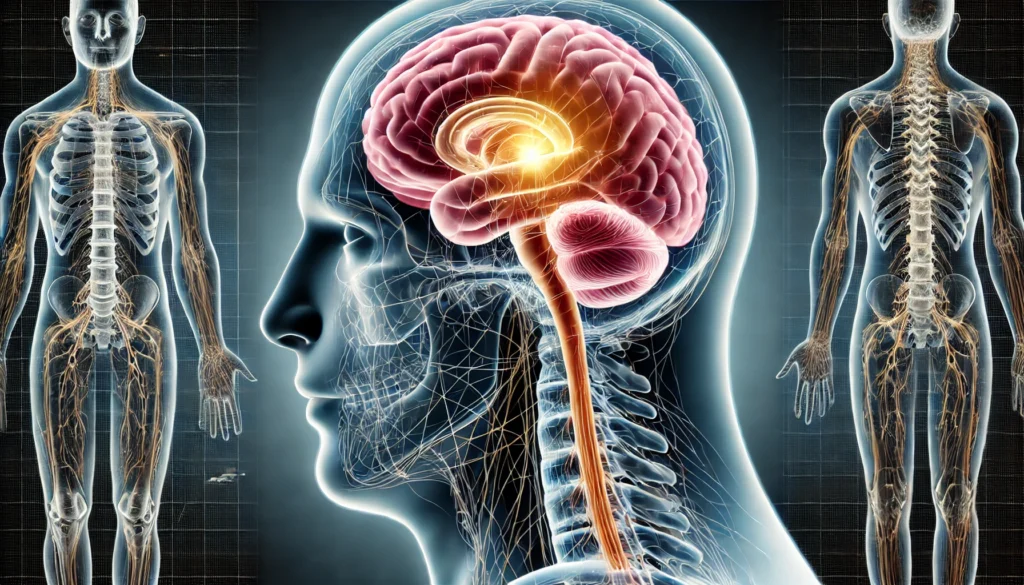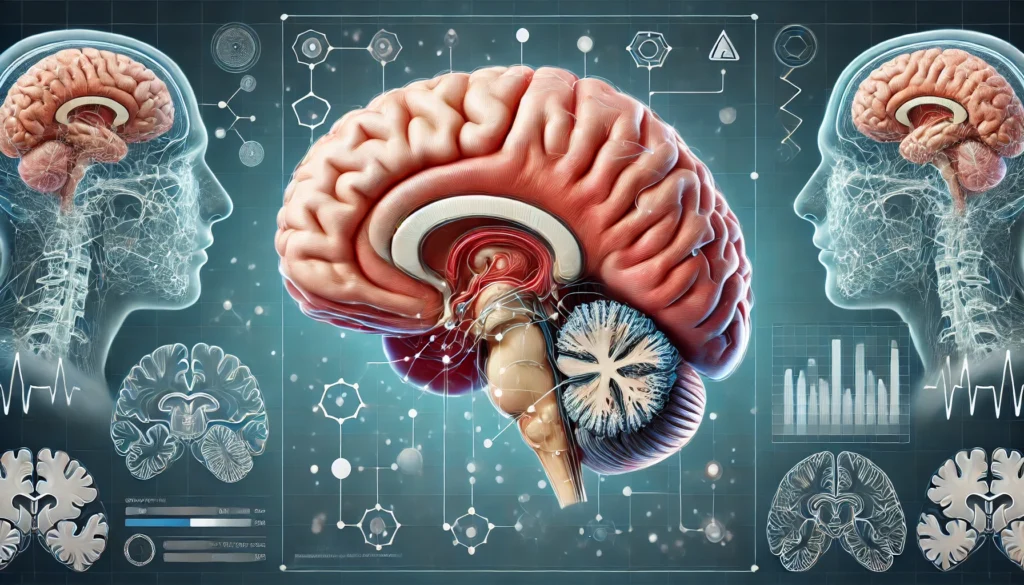The human brain, a marvel of biological engineering, is composed of numerous parts that each play distinct roles in our daily functioning. From the cerebral cortex to the brainstem, each section serves specific purposes that are crucial for our survival and well-being. Understanding how to remember these parts using mnemonics can be incredibly helpful.
You may also like: Memory Techniques for Better Studying
Structural Complexity
The brain’s complexity is evident in its structure, which includes billions of neurons and trillions of synapses. Each component, from the tiny neural circuits to large lobes, plays a role in processing information. This complex structure allows for the high-level thinking, emotion processing, and sensory integration that defines human experience. Recognizing these parts and their interconnections is essential for anyone delving into brain science.
Functional Diversity
Beyond its structural complexity, the brain’s functional diversity is what makes it so remarkable. It manages everything from basic survival functions to sophisticated cognitive processes. Different brain areas are specialized for various tasks, such as language, movement, and sensory perception. This specialization allows for efficient processing and rapid response to environmental changes, highlighting the brain’s adaptability.
Evolutionary Perspective
From an evolutionary standpoint, the human brain has undergone significant changes over millennia. This evolution has resulted in a highly advanced organ capable of language, abstract thought, and problem-solving. Understanding its evolutionary roots can offer insights into why certain structures are more developed and how they contribute to our unique cognitive abilities. This perspective enriches our appreciation of brain anatomy and its mnemonic learning.
The Importance of Memorizing Brain Parts
For professionals like health and wellness coaches, knowing brain anatomy allows for a deeper comprehension of how lifestyle choices affect mental health. Science journalists benefit from this knowledge by accurately reporting on brain-related stories, while biohackers use it to optimize cognitive function and overall brain health.
Professional Relevance
For those in professions related to health, education, and technology, memorizing brain parts is not just academic but practical. Health professionals use this knowledge to understand mental health disorders better and develop effective treatment plans. Teachers incorporate it into curricula to help students grasp essential biological concepts. Tech innovators look to brain anatomy for inspiration in developing artificial intelligence.
Enhancing Communication
Memorizing brain parts enhances communication between experts and the public. By understanding and accurately describing brain functions, professionals can convey complex ideas more clearly. This ability to communicate effectively about brain science fosters greater public understanding and interest in neuroscience, paving the way for informed discussions on mental health, education, and technology.
Personal Development
Beyond professional applications, understanding brain anatomy can enhance personal development. Individuals interested in self-improvement can use this knowledge to explore how different brain regions influence behavior and decision-making. By applying mnemonic techniques, one can better retain this information, leading to more informed lifestyle choices that promote brain health and cognitive longevity.
Why Use Mnemonics?
Mnemonics are memory aids that help simplify complex information. By transforming abstract concepts into memorable phrases or associations, mnemonics make it easier to recall details. They have been used historically to aid learning, dating back to ancient Greece.
Cognitive Benefits
Mnemonics capitalize on the brain’s natural ability to recognize patterns and make associations. By creating memorable links between new information and what is already known, mnemonics enhance recall efficiency. This cognitive strategy is particularly beneficial when dealing with complex subjects like brain anatomy, providing a scaffold for integrating new knowledge seamlessly.

Historical Roots
The use of mnemonics dates back to ancient civilizations, where orators and scholars relied on them to memorize lengthy speeches and texts. This historical context underscores the enduring utility of mnemonic devices in human learning. Ancient techniques, such as the method of loci, have been adapted over time, proving their versatility in modern educational and professional settings.
Modern Applications
Today, mnemonics are widely used in educational systems worldwide. Teachers employ them to aid students in retaining challenging material, while professionals use them to remember intricate details relevant to their fields. Digital tools and apps have further expanded mnemonic applications, offering interactive and personalized learning experiences that cater to diverse learning styles.
Key Brain Parts and Mnemonics
Cerebral Cortex
The cerebral cortex is the brain’s outermost layer, responsible for complex functions like thought and action. To remember this, use the mnemonic “Clever Cats Think and Act,” where each word represents the initial ‘C’ for cerebral cortex and highlights its key functions.
Functionality and Importance
The cerebral cortex is integral to higher-order brain functions, including perception, cognition, and decision-making. Its role in these complex processes makes it a focal point in brain studies. Understanding its structure and function is essential for anyone interested in cognitive sciences, as it offers insights into how we process information and respond to our environment.
Mnemonic Technique
“Clever Cats Think and Act” simplifies the cerebral cortex’s complex role into a catchy phrase. This mnemonic aids in retaining the cortex’s core functions, making it accessible to learners of all backgrounds. By associating the cerebral cortex with cleverness and action, this technique effectively encapsulates its essence in a memorable way.
Practical Implications
Knowing the cerebral cortex’s functions through mnemonics can enhance one’s ability to understand neurological conditions and cognitive processes. This knowledge is applicable in fields like psychology, where brain function is linked to behavior and mental health. It also benefits educators and students in breaking down complex neuroscience concepts into digestible content.
Limbic System
The limbic system is often associated with emotions and memory. A useful mnemonic is “Hats Make Emotional Memories,” where ‘Hats’ stands for Hippocampus, Amygdala, Thalamus, and Septum. Each component contributes uniquely to emotional processing and memory storage.
Emotional Processing
The limbic system’s role in emotion is crucial for understanding human behavior and mental health. Each of its components, such as the amygdala, plays a significant part in emotional regulation and reaction. Recognizing these functions through mnemonics aids in grasping the complexities of emotional intelligence and its impact on interpersonal relationships.
Memory Storage
This system is also vital for memory formation and retrieval, with the hippocampus being a key player. Mnemonics like “Hats Make Emotional Memories” help encode these relationships, making it easier to recall which brain parts are responsible for these functions. This understanding supports fields like psychiatry and education, where memory plays a pivotal role.
Broader Applications
Understanding the limbic system’s functions through mnemonics can improve approaches in therapy, education, and self-help. It helps professionals explain emotional and memory-related phenomena to clients or students, fostering a deeper appreciation of the brain’s influence on everyday life. This knowledge is particularly beneficial in developing emotional intelligence skills.
Brainstem
The brainstem, essential for regulating vital functions such as breathing and heart rate, can be remembered with “Beating Hearts Beat,” which emphasizes its role in involuntary actions.
Vital Functions
The brainstem is crucial for maintaining life-sustaining functions, making it an area of interest in medical studies. Understanding its role in autonomic functions like heart rate and respiration helps in diagnosing and treating disorders that affect these critical systems. This knowledge is essential for health professionals and students in medical fields.
Mnemonic Simplification
“Beating Hearts Beat” succinctly captures the brainstem’s primary responsibilities, making it an effective mnemonic. By focusing on its role in involuntary actions, this phrase highlights its importance in sustaining life, providing a simple way to remember its functions without delving into complex scientific terminology.
Impact on Health Sciences
Comprehending the brainstem’s functions through mnemonics aids in understanding neurological disorders and conditions. This understanding is crucial for developing treatments and interventions that address autonomic dysfunctions. It also supports health educators in conveying complex medical information to patients in an accessible manner.
Cerebellum
The cerebellum coordinates voluntary movements and balance. The mnemonic “Careful Balance” highlights its function in movement control and equilibrium maintenance.
Coordination and Balance
The cerebellum’s role in movement and balance is vital for physical coordination. It integrates sensory input with motor commands to fine-tune muscle activity, ensuring smooth and precise movements. This function is crucial in fields like sports science and rehabilitation, where understanding motor control can enhance performance and recovery.
Mnemonic Clarity
“Careful Balance” effectively summarizes the cerebellum’s primary functions, providing a clear and concise way to remember its role. This mnemonic emphasizes the cerebellum’s importance in maintaining equilibrium, making it relevant for learners interested in motor skills and physical health.
Practical Significance
Understanding the cerebellum through mnemonics is valuable in developing strategies for improving motor skills and balance. This knowledge is applicable in physical therapy, sports training, and even daily activities that require coordination. It also enhances educational approaches by simplifying complex anatomical concepts for students and practitioners.
Integrating Mnemonics into Learning
Historical Context
Mnemonics have a rich history, dating back to ancient rhetoric scholars who used them to memorize speeches. This technique remains relevant today, especially in educational settings where complex subjects like neuroscience are taught.
Ancient Origins
The origins of mnemonics can be traced back to ancient Greek and Roman civilizations. Scholars and orators employed mnemonic techniques to aid memory retention, particularly in oral traditions where written records were scarce. This historical usage underscores the timelessness and adaptability of mnemonics in facilitating learning across cultures and eras.
Educational Evolution
As education systems have evolved, so too have the applications of mnemonics. From rote memorization in traditional classrooms to innovative digital learning environments, mnemonics have adapted to various teaching methodologies. Their enduring presence in education highlights their effectiveness in bridging the gap between complex information and learner comprehension.
Cultural Significance
Mnemonics hold cultural significance in preserving knowledge across generations. They have been used to pass down oral histories, religious texts, and cultural traditions. This cultural relevance enriches the learning experience, providing context and depth to the information being memorized, whether in historical studies or modern educational settings.
Current Trends
In modern education, mnemonics are increasingly used to enhance learning efficiency. Digital platforms and applications now offer mnemonic-based learning tools, making it easier for students and professionals to grasp complex topics.
Technological Integration
The rise of digital technology has revolutionized the use of mnemonics in learning. Online platforms and educational apps offer interactive mnemonic tools that cater to different learning styles. These digital resources enhance accessibility and engagement, allowing learners to customize their study approaches and improve retention rates.
Cross-Disciplinary Applications
Mnemonics are finding applications beyond traditional educational settings. In fields like medicine, law, and business, professionals use mnemonic devices to retain intricate details and streamline information recall. This cross-disciplinary application underscores the versatility of mnemonics in supporting lifelong learning and professional development.
Personalized Learning
The trend toward personalized education has amplified the use of mnemonics. By tailoring mnemonic techniques to individual learning preferences and cognitive profiles, educators can enhance learner outcomes. This personalized approach fosters deeper engagement and understanding, making complex subjects more approachable and less daunting.
Future Implications
As neuroscience advances, mnemonics may evolve to incorporate new findings about brain function and learning processes. They hold potential for developing personalized learning strategies based on individual cognitive profiles.
Neuroscientific Insights
Emerging research in neuroscience is shedding light on how the brain processes and stores information, offering new insights into the effectiveness of mnemonics. Understanding these mechanisms can lead to the development of more sophisticated mnemonic techniques that align with natural cognitive processes, enhancing learning efficiency and retention.

Adaptive Learning Technologies
Future advancements in adaptive learning technologies may incorporate mnemonics into personalized educational platforms. By analyzing learners’ cognitive strengths and weaknesses, these technologies can recommend tailored mnemonic strategies that optimize learning outcomes. This integration represents a promising frontier in education, combining neuroscience and technology for enhanced learning experiences.
Broader Educational Impact
The evolution of mnemonics in response to scientific discoveries and technological innovations could transform educational practices. By incorporating these insights into curricula and teaching methodologies, educators can better equip students with the tools to tackle complex subjects. This broader educational impact underscores the potential of mnemonics to revolutionize how we approach learning in the 21st century.
Practical Applications of Mnemonics
For Health and Wellness Coaches
Using mnemonics, coaches can better explain to clients how different brain parts influence mental health. This knowledge empowers clients to make informed lifestyle choices that enhance cognitive and emotional well-being.
Client Education
Mnemonics serve as a powerful tool for educating clients about brain health. By simplifying complex anatomical information, coaches can effectively communicate how different brain regions impact emotions, stress, and mental wellness. This understanding empowers clients to make proactive choices that support their mental health goals.
Lifestyle Integration
Health and wellness coaches can use mnemonic techniques to integrate brain health concepts into lifestyle recommendations. By associating specific lifestyle changes with brain functions, clients can better understand how their habits influence cognitive and emotional well-being. This integration fosters a holistic approach to health, emphasizing the mind-body connection.
Empowerment and Motivation
Mnemonics can also motivate clients to take charge of their mental health journey. By demystifying brain anatomy and its impact on well-being, clients feel more empowered to implement changes. This empowerment is crucial in sustaining motivation and commitment to long-term health and wellness goals.
For Science Journalists
Journalists can leverage mnemonics to break down brain science into digestible content for the public. This approach enhances their ability to communicate complex scientific information engagingly and accurately.
Simplifying Science
Science journalists face the challenge of conveying intricate scientific concepts to a general audience. Mnemonics provide a solution by distilling complex information into easily understandable and memorable phrases. This simplification enhances the accessibility of scientific content, fostering greater public interest and understanding.
Engaging Storytelling
Mnemonics can enhance storytelling by adding a layer of creativity and engagement to scientific narratives. By incorporating memorable phrases and associations, journalists can capture readers’ attention and make complex topics more relatable. This storytelling approach enriches the reader’s experience and promotes a deeper connection with the material.
Accuracy and Clarity
Using mnemonics helps journalists maintain accuracy and clarity in their reporting. By ensuring that essential details are remembered and communicated effectively, journalists can avoid misinterpretations and inaccuracies. This precision is vital in maintaining credibility and trust with their audience, particularly in science communication.
For Biohackers
Biohackers benefit from mnemonics by gaining a clearer understanding of brain anatomy, aiding in the selection of targeted interventions for cognitive enhancement. This knowledge supports their quest for optimal mental performance.
Cognitive Mapping
For biohackers, understanding brain anatomy is key to mapping cognitive processes and identifying areas for enhancement. Mnemonics provide a framework for memorizing the intricate details of brain function, facilitating a more targeted approach to cognitive optimization. This understanding enables biohackers to experiment with interventions more effectively.
Targeted Interventions
With a solid grasp of brain anatomy, biohackers can select interventions that align with specific cognitive goals. Mnemonics aid in recalling which brain regions are associated with desired outcomes, such as improved memory or focus. This targeted approach maximizes the effectiveness of biohacking strategies, supporting optimal mental performance.
Continuous Learning
Mnemonics also support continuous learning in the biohacking community. By simplifying complex brain science, biohackers can stay updated on the latest research and developments. This ongoing education is crucial for refining techniques and incorporating new insights into their cognitive enhancement practices.

Conclusion
Understanding the brain’s anatomy is crucial for various professions and interests, from health coaching to science journalism and biohacking. Mnemonics offer a practical solution for memorizing brain parts, making this complex subject more accessible and engaging. By integrating historical context, current trends, and future implications, mnemonics not only enhance learning but also open new avenues for applying brain science in everyday life.
Embracing Mnemonic Learning
Incorporate these mnemonic techniques into your learning routine and witness the difference they make in mastering the intricate world of brain anatomy. Whether you’re optimizing your own cognitive abilities or educating others, mnemonics are a valuable tool in your arsenal.
Expanding Knowledge Horizons
As you delve deeper into brain anatomy using mnemonics, you’ll expand your knowledge horizons and unlock new possibilities for personal and professional growth. This exploration enriches your understanding of the brain’s role in shaping human experience, providing a foundation for informed decision-making and innovation.
Future Prospects
The future of mnemonic learning is bright, with advancements in neuroscience and technology promising even more effective and personalized techniques. By staying informed and adaptable, you can harness the power of mnemonics to enhance your learning journey and contribute to the evolving landscape of brain science.
Further Reading:
Brain Anatomy and How the Brain Works
Is there an easy way to remember the brain lobes and their functions?
Important Note: The information contained in this article is for general informational purposes only, and should not be construed as health or medical advice, nor is it intended to diagnose, prevent, treat, or cure any disease or health condition. Before embarking on any diet, fitness regimen, or program of nutritional supplementation, it is advisable to consult your healthcare professional in order to determine its safety and probable efficacy in terms of your individual state of health.
Regarding Nutritional Supplements Or Other Non-Prescription Health Products: If any nutritional supplements or other non-prescription health products are mentioned in the foregoing article, any claims or statements made about them have not been evaluated by the U.S. Food and Drug Administration, and such nutritional supplements or other health products are not intended to diagnose, treat, cure, or prevent any disease.


